|
|
|
Dalhousie
Attractions,
Himachal Pradesh |
| |
|
|
|
|
|
Tourist Attractions in Dalhousie
All local sightseeing can be done on foot in Dalhousie. The
main tourist attractions in Dalhousie are Panchpula, Kalatop
and Khajjiar lake. The other tourist attractions are Kynance,
Subhash Baoli, St. Andrew's Church, St. Patrick's Church, St.
Francis Church, St. John'S Church, Lakshmi Narayan Temple,
Radha Swami Satsang Bhawan and Hospital, Shivkul, Dakshina
Murti, Norwood Paramdham, Banikhet, Lakkarmandi, Bharmaur,
Mani Mahesh and Chhatrari. |
|
|
|
Panchpula
Panchpula, a beautiful spot, is barely 3 kms. from G.P.O.
On the way to Panchpula is Satdhara springs gurgling
with refreshing water, believed to contain some
medicinal properties. Panchpula stream is the main
source of water supply to Dalhousie and Bahloon. The
stream springs from the north side of DayanKund and runs
down a picturesque ravine to the waterworks of Panchpula.
There is an elegant monument erected at Panchpula where
several streams meet at one point. This monument, a
Samadhi was built in memory of great revolutionary
Sardar Ajit Singh who breathed his last in Panchpula.
Kynance
Kynance is a private residential building of Dharamvirs.
This building was constructed during the year 1933 by
Dr. N. R. Dharamvir of Lahore. This building acquired
historical significance due to the reason that Neta Ji
Subhash Chander Bose, a class fellow of the wife of Dr.
Dharamvir, |
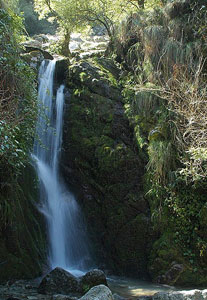 |
|
|
stayed with
them for a period of 7 months beginning May, 1937.
Before arriving in Dalhousie, Neta Ji was in British Jail
where his health had deteriorated. On the request of his
younger brother the British High Court released Neta Ji on
parole on health grounds. It brought Neta Ji to the climate of
Dalhousie. Kynance is barely 50 kms. from G.P.O. It lies
hidden from the public eye below the road. An insignificant
looking board bearing the name of Kynance hangs from a tree
and is discernible to only those tourists who have an eye for
details.
Subhash Baoli
Just approximately 1 km from G.P.O. is a charming natural spot
called Subhash Baoli. Neta ji Subhash Chander Bose during his
7 months sojourn in Dalhousie in 1937 is believed to have
spent most of his days by the side of this water body,
meditating amidst dense woods of Cedar and meeting his party
workers. This place lies on the G.P.O. - JandriGaht Road. A
canopy with seating facilities has been created by the local
administration at this place.
St. Andrew's Church
St. Andrew's Church commonly known as the Church of Scotland
was built in the year 1903 at Balloon by Protestant Christians.
The Church is approximately one and half kms. from Dalhousie's
bus stand. The Church building is in good condition, recently
a brick boundary wall has been erected around it to save the
building from mischief mongers.
St. Patrick's Church
St. Patrick's Church is situated in Baloon, Dalhousie Cantt.,
on Military Hospital road approximately 2 kms. from main bus
stand. St. Patrick's Church is the largest church in Dalhousie
having a seating capacity of 300 persons in its main hall. The
Church was built in the year 1909 and the dressed-stone
building is still in good condition. This Church was built
exclusively from contribution made by officers and ranks of
the British Army. At present the Church is managed and
maintained by the Catholic Diocese of Jalandhar.
St. Francis Church
St. Francis Church is a very prominent monument on the Subhash
Chowk. This Church was built in the year 1894 from the
contributions made by Army and Civil Officers and Civilians.
This Church is managed and maintained by the Cathoilic Diocese
of Jalandhar. St. Francis' Church on Prtrain hill is believed
to have been built on the lines of a certain church in
England. Beautiful glass work and intricate stone work can be
seen in the Church. Service is conducted every Sunday. By the
side of the Church is the residence of the Priest. The
building is called Alverna better known to the local people as
"Lambe Chole Wale Padri Ki Kothi". |
|
|
|
St.
John's Church
St. John's Church stands on the Gandhi Chowk
approximately 2 kms. from the main bus stand of
Dalhousie. This Church was the first to be built after
the town of Dalhousie was founded. Prior to 1863 a
wooden structure stood at this place. The idea to build
a stone structure took birth with the arrival of Rev.
John H. Pratt who came to Dalhousie on 11-04-1863 and
inspired the Christian community to build a permanent
church building at this place. Building of this church
is a copy of Roman Catholics church of England but this
church belongs to Protestants. The church building
stands in a good condition but its surroundings demand
much better care. Service is conducted on every Sunday.
Lakshmi Narayan Temple
The Lakshmi Narayan Temple is dedicated to Lord Vishnu
and was built more than 150 years ago. The temple
enshrines a beautiful image of Lord Vishnu. The temple
is |
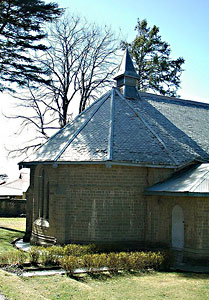 |
|
|
frequented by
local devotees. The temple is located in Sadar Bazar, about
200 meters from Subhash Chowk.
Radha Swami Satsang Bhawan and Hospital
Dalhousie holds great significance for the followers/disciples
of Radha Swami sect of Beas (Punjab). The Radha Swami Satsang
Bhawan is situated near Moti Tibba, about 300 meters from
Gandhi Chowk (G.P.O). In recent times many people from the
nearby villages of Dalhousie have embraced the Radha Swami
Sect. Every Sunday from 10 AM to 11 AM Satsang is held in the
above cited premises. The Present Radha Swami Chief Maharaj
Gurinder Singh Ji visits Dalhousie twice a year. Even the Late
Maharaj Charan Singh Ji was very fond of Dalhousie. It is
believed that Baba Swarn Singh Ji was enlightend in Dalhousie.
Shivkul
Shivkul is an Ashram of Vimala Thakur, a renowned religious
philosopher lady from Gujarat. Shivkul is on the Mall Road
betwen Gandhi Chowk and Subhash Chowk. From here one can enjoy
the beautiful panorama of Pir Panjal Hills, connecting Chamba
Distt. with Jammu & Kashmir. During summer when Vimala Hi
popularly known as Vimala Bahen comes to Dalhousie many
foreigners as well as Indian disciples of Vimala Ji from all
parts of the coutry and abroad gather in Dalhousie to attend
her lectures on spiritualism.
Dakshina Murti
Dakshina Murti is a yoga institution created by Dr. R. P.
Kaushik of Sonepat/Delhi during mid seventies. Dr. Kaushik
traveled all over the world to teach yoga and spiritualism.
He died in July 1987. His followers still come to Dalhousie
and stay at Dakshina Murti. |
|
|
|
Kalatop
Kalatop and Khajiar are best explored if you take a
three days walk from Dalhousie to Kalatop, Khajjiar and
back. The trek is more or less level and requires good
health, a pair of sturdy walking shoes. Kalatop is 10
kms from G.P.O. at an altitude of 8000 feet. Walking
along the secluded and forested road through upper
Nakorota hills, one reaches Lakkarmandi. Between G.P.O.
and Lakkarmandi lies the Dalhousie water system, Tibetan
Handicraft Centre and Dalhousie Potato Farm at Ahla.
Lakkarmandi is nestled between 8600 feet high DayanKund
peak on its right and |
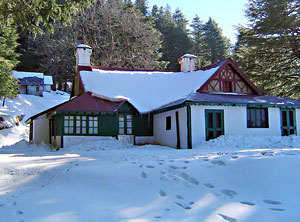 |
|
|
Kalatop on
the left. Dayan Kund has military installations and is closed
to civilians except the local people who visit Bhulwani Mata
temple near DayanKund.
Lakkarmandi
Lakkarmandi is home for Dhogri families that are engaged in
charcoal making. Most of the dhogris have been driven to
plains because of the fall in the demand for charcoal. At
Lakkarmandi there is a Wildlife Barrier to check movement of
vehicles on the unpaved but narrow level road that runs 3 kms
to Kalatop Forest Rest House. The walk from Lakkarmandi to
Kalatop is through dense forest of pines and deodars. The
solitude is occasionally broken by singing birds. The blissful
solitude of Kalatop is ideal for the honeymooners.
Bharmaur
65 kms from Chamba is the land of legendary Gaddies, i.e.
Bharmaur. Known as Brahmpur in the 6th century, was the seat
of power of Chamba state for some 400 years till AD 920, when
a new capital was founded at Chamba by Raja Sahil Varman.
Bharmaur is known for some very old archaeological remains,
primarily the temples. All these temples stand on a level area
which call the Chaurasi after the 84 Siddhas who are believed
to have meditated in Bharmaur over 1000 years ago. These
Siddhas hailed from Kurukshetra and visited Manimahesh. The
oldest temples in the complex are those of Lakshna Devi and
Ganesh. Both these temples are made in the hill style with
gable roofs and rubble masonry. The outer facade, the inner
facade of sanctum, circum ambulatory path and the ceiling are
exquisitely carved. The idol of Lakshna Devi in her
incarnation as Mahisasurmardini is magnificent. The tallest
temple in the whole complex is of Manimahesh built in Shikhara
style of architecture. The temple has a Shivalingam on a
raised platform. The other temple in Shikhara style is of Nar
Singh. Lord Vishnu in his avtar as Nar Singh has been cast
vividly. There is a bronze Nandi of life size which stands
facing the Manimahesh temple. Inscriptions on the pedestal of
the bull and on the idols of Lakshna Devi and Ganesh date back
to the reign of Raja Meru Varman. These idols are believed to
be the work of master craftsman Gugga. There is a small water
source called Ardh Ganda in a corner of the temple complex.
Bathing in its water is considered religiously significant.
The country around Bharmour is regarded as belonging to Shiva
and is sometimes called Shiv-Bhumi. Being the home of nomadic
shepherds Gaddies it is also called Gadderan. Just 4 kms above
Chaurasi temples is the hill temple of Bharmani Devi. A trek
to this temple refreshes the visitors as it unfolds the green
woods before him. The best period to visit Bharmour is between
July and September. Bharmour is also known for its delicious
apples and local blankets. |
|
|
|
Khajjiar
23 kms from Dalhousie by road and 13 kms from Kalatop is
the mini Switzerland of India at a height of 6400 ft.
Hutchison writes, "Khajjiar is a forest glade of great
beauty, 6400 feet above sea level". Khajjiar is often
reffered to as "Gulmarg of Himachal Pradesh". The lush
green meadows are surrounded by thick pine and cedar
forests. Grazing herds of sheep, goats and other milch
cattle present a prefect pastoral scenery. There is a
small lake in the center of the saucer shaped meadow
which has in |
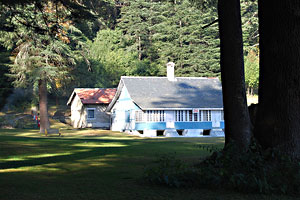 |
|
|
it a floating
island. Much of the lake has degenerated into slush because of
heavy silting during rains. Still the landscape of Khajjiar is
picturesque and a photographer's delight. A little away from
the lake is the temple of Khajji Nag belonging to 12th C. AD.
In the mandapa of the temple one can see the images of the
Pandavas and the defeated Kaurvas hanging from the roof of the
circumambulatory path. The sanctum of the temple has been
beautifully carved from wood. There is a Tourism Hotel and
some Tourism cottages at Khajjiar where the tourists can stay
. Besides there are two rest houses one each of P.W.D. and
Forest Deptt. A couple of private hotels have also come up,
which do not match the above places in terms of location and
amenities. Bus service to and from Khajjiar is limited and
timings change according to local demands. There used to be a
golf course in Khajjiar which is not maintained. The best
entertainment in Khajjiar is to walk around the lake or to go
for long walks in the thick pine forests. Children enjoy this
place because of the freedom of movement and the slopy terrain
which permits them to roll down to the lake without getting
hurt. Another attraction like any other hill station is horse
riding. On 07-07-1992, Mr. Willy t. Blazer, Vice Counselor and
Head of Chancery of Switzerland in India brought Khajjiar on
the world tourism map by christening it "Mini Switzerland". He
also put a sign board of a yellow Swiss hiking footpath
showing Khajjiar's distance from the Swiss capital Berne-6194
kms. Khajjiar is among the 160 locations in the world that
bear topographical resemblance with Switzerland. The Counselor
also took from Khajjiar a stone which will form part of a
stone collage around the Swiss Parliament to remind the
visitors of Khajjiar as Mini Switzerland of India.
Bharmaur
65 kms from Chamba is the land of legendary Gaddies, i.e.
Bharmaur. Known as Brahmpur in the 6th century, was the seat
of power of Chamba state for some 400 years till AD 920, when
a new capital was founded at Chamba by Raja Sahil Varman.
Bharmaur is known for some very old archaeological remains,
primarily the temples. All these temples stand on a level area
which call the Chaurasi after the 84 Siddhas who are believed
to have meditated in Bharmaur over 1000 years ago. These
Siddhas hailed from Kurukshetra and visited Manimahesh. The
oldest temples in the complex are those of Lakshna Devi and
Ganesh. Both these temples are made in the hill style with
gable roofs and rubble masonry. The outer facade, the inner
facade of sanctum, circum ambulatory path and the ceiling are
exquisitely carved. The idol of Lakshna Devi in her
incarnation as Mahisasurmardini is magnificent. The tallest
temple in the whole complex is of Manimahesh built in Shikhara
style of architecture. The temple has a Shivalingam on a
raised platform. The other temple in Shikhara style is of Nar
Singh. Lord Vishnu in his avtar as Nar Singh has been cast
vividly. There is a bronze Nandi of life size which stands
facing the Manimahesh temple. Inscriptions on the pedestal of
the bull and on the idols of Lakshna Devi and Ganesh date back
to the reign of Raja Meru Varman. These idols are believed to
be the work of master craftsman Gugga. There is a small water
source called Ardh Ganda in a corner of the temple complex.
Bathing in its water is considered religiously significant.
The country around Bharmour is regarded as belonging to Shiva
and is sometimes called Shiv-Bhumi. Being the home of nomadic
shepherds Gaddies it is also called Gadderan. Just 4 kms above
Chaurasi temples is the hill temple of Bharmani Devi. A trek
to this temple refreshes the visitors as it unfolds the green
woods before him. The best period to visit Bharmour is between
July and September. Bharmour is also known for its delicious
apples and local blankets. |
|
|
|
Mani Mahesh
In the month of August/September the famous Jatra of
Mani-Mahesh commences from Laxmi-Narayana Temple in
Chamba. The Chhari is taken to the sacred lake of Mani-Mahesh,
which is one of the chief tirthas in the district. Off
late people from north India and beyond have started
visiting this sacred lake. According to an estimate
nearly one lakh people visit this sacred lake every year
and take a holy dip. The lake is situated at the height
of 13,500 feet above sea level and at the base of Mani-Mahesh Kailash peak
(18,564 feet). Mani-Mahesh
|
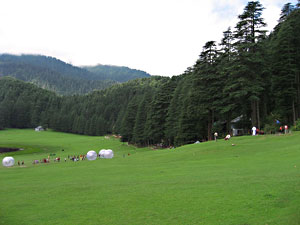 |
|
|
Kailash is a virgin peak. In 1968
an Indo-Japanese team led by Nandini Patel made an
unsuccessful attempt to scale the peak. The devout attribute
the failure to the divine powers of the holy mountain. On
the margin of the lake is a small marble Shivalinga called
Chaumukha. Mani-Mahesh is 35 kms. from Bharmour. During mela
days efficient bus service is available upto Hadsar. The
pilgrimage is generally done in two stages. First camp is
set-up at Dhanchho. Several grazers can be seen grazing their
sheep in the alpine pastures of this place. the ascent from
Chanchho to Mani-Mahesh lake is difficult in patches. Just
short of the lake is Gauri Kund where women take a holy dip
before returning to home. The pilgrimage to Mani-Mahesh is
considered sacred like that of Amarnath, Badrinath and
Rameshwarm. During the mela days several Bhandaras are set-up
for the benefit of pilgrims and meals are served free of cost.
Pack animals are also available for those who do not want to
carry their luggage themselves.
Chhatrari
45 kms from Chamba via road is this famous village of
Chhatrari. The village is inhabited mostly by the Gaddies who
are semi-postral lot engaged in rearing of sheep and goats.
This village, situated at a height of 6000 feet, its famous
for its remarkable hill-style temple of Shamti Devi. The
temple of Chhatrari is regarded as one of the holiest ones
competing with well known temples of "Lakshna Devi" at
Bharmour and of "Bhawani" at Kangra. The construction of the
temple is simple. It consists of a small Cell or sanctuary in
which one of the rare brasses by the master craftsman Gugga is
enshrined. The walls of the temple are built of rubble masonry
alternating with beams of wood. The structure is surmounted by
a sloping roof of slate. The roof is supported by richly
craved wooden posts which form a Verandah or circumambulatory
path round the sanctum. The Shakti Devi temple is of interest
owning to the elaborate decoration of its facade, ceiling and
pillar. The sanctum, its architecture and sculpture betray a
conscious effort on part of its builder to introduce a highly
refined post Gupta art in this remote part of Chamba. The main
idol in the temple is that Shakti. This fine brass statue, 4
feet 6 inches tall shows Shakti holding in her hands a lance
(Power, energy) and a lotus (life), a bell (aether, space) and
a snake (death and time). Besides this main idol there are
almost thirty other small figurines of tutelary deities like
Annapurna. Some of these are believed to have been brought
from far South or the State of Orrisa. According to the
inscription at Chhatrari the temple was built by Raja Meru
Varman, by whose order the inscription was engraved along with
the names of his father, grand father and great grand father
as well as that of the sculptor. This epigraph commemorates
Meru Varman's victory over his rivals with the help of the
Devi. The outer walls of the sanctum are covered with frescoes
which are of recent origin and represent scenes from Puranas.
Near the Shakti Devi Temple is the temple of Gauri Shankra.
The stone image of Gauri Shankra is of later origin. The work
can be attributed to the 10th century AD which indicates a
long period of sculptural activity in the region.
A few minutes walk up the mountain slopes
from the main village is the Charauta temple which houses a
stone image of Bhatod Nag who gives water to the people in
return for one black and four white goats every three years.
There are two interesting legends connected with the village.
Villagers had to fetch water from a nearby village call Makain.
Once, a Chela of a siddha while carrying water fell prey to
bears. The Siddha invoked the deity to solve the water
problem. Inspired by the Devi he made 36 marks with his
trident at different places in the village and water gushed
out from the points where the marks had been made. There are
36 water sources in the village around which beautiful
Panihars (Fountain slabs) can be seen. According to J.
Hutchison the village was named Chhatrari at a later date when
Raja Bala Bhadra (1589-1611) made a grant of 36 Larhis to the
temple following an accidental death of a cow at the hands of
the Raja. One larhi is equal to three acres of land and such
Lahris are today known as Chhatrari. In the month of September
a mela is held on the third day after the mela at the Mani-Mahesh
lake whence a man brings a Lota of water with which the idol
of Shakti is bathed. On this day a number of sheep are slain
to appease the goddess and to invoke her blessings. After the
prayer the gaddies in their traditional costumes dance to the
tune of local music. The village is approached either from
Gehra from where a bridle path leads to Chhatrari or from
Luna-Ka-Pul from where a steep trace is to be ascended to
reach the village or by the motorable road, experiencing a
scary ride almost 700 to 900 feet above the river Ravi as one
nears the village. The ascent on foot is most rewarding as the
visitors are welcomed by lush green fields and orchards at the
outskirts of Chhatrari. Chhatrari looks most scenic during
September and October. Even on other occasions, particularly
in spring, Chhatrari offers pleasant scenery. |
|